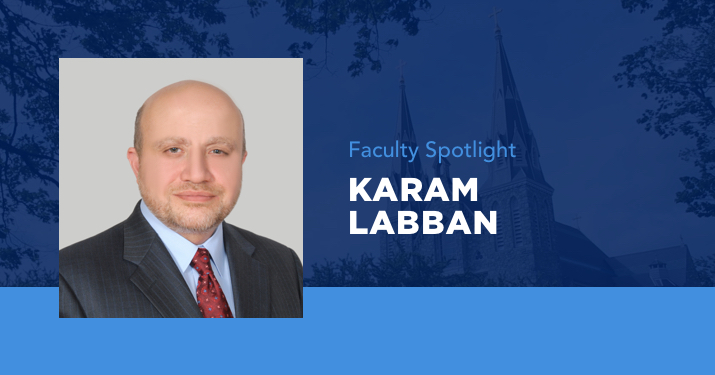
Agile Practitioner Says Leadership, New Mindset Provide Keys To Successful Agile Implementation
Agile Practitioner Says Leadership, New Mindset Provide Keys To Successful Agile Implementation

Last Updated March 8, 2024
Karam Labban has more than 20 years of professional experience as a project manager and certified Agile practitioner. While satisfied with his successes on the job, teaching students in Villanova University’s 100% online Certificate in Agile program allows him to tap into something he enjoys just as much.
“I love sharing knowledge,” Labban said. “The knowledge sharing of something you believe in – and thinking that you could help individuals and organizations to do better – is a great motivator.”
In an interview, Labban spoke about how his professional experiences inform his teaching, the importance of Agile certification and how to overcome some of the biggest challenges of implementing Agile in an organization.
His Transition from Project Management to Agile
Labban holds a Bachelor of Science in Computer Science with a minor in management and accounting from the University of Nebraska and a Master of Science in Information Technology Management from Creighton University.
He earned Project Management Professional (PMP)® certification after he reached a point in his career when he was “developing and maintaining two large systems for my workplace. The idea of becoming a project manager started to look like a logical progression for my career. So, I applied for the role and also obtained my PMP® certification.”
While Labban worked successfully as a project manager early in his career, it was in 2006 that he began thinking about making the transition to an Agile role after having a conversation with a friend.
“I was feeling that I was doing more than just following the pre-defined processes, updating documentations and working out the issues that came with waterfall-based projects. My friend suggested that I look up something fairly new called Scrum and the Agile Manifesto,” he said.
“I jumped on the suggestion right away and my outlook on my professional life forever changed. It was a methodology and mindset that valued building teams and listening to customers throughout the process,” Labban said.
Incorporating Professional Experience in the Classroom
While Agile as we know today started in the software industry, the methodology has since spread to many industries. Villanova’s Agile program introduces students to the concept of using Agile to improve areas such as time to market, efficiency and customer satisfaction.
After transitioning from a project management role to Agile, Labban gained experience in a number of industries and worked in many roles within Agile, including as an Agile Coach, Agile Scrum Trainer, Agile Advocate and Agile Scrum Master. He uses those experiences to expand on what he teaches students.
Labban said he makes sure to “anchor my classes to formal teachings of different Agile practices. I tend to share my opinions based on my experience or what I have seen from others’ experience and how that relates to the Agile Manifesto principles and values.”
Throughout the years, Labban has earned numerous Agile-related certifications including Certified Scrum Professional (CSP), Certified Scrum Master (CSM), PMI-Agile Certified Practitioner (PMI-ACP)®, Team Kanban Practitioner (TKP) and AgilityHealth Facilitator (AHF), as well as other certifications in product ownership and scaled Agile frameworks. This helps him incorporate his industry knowledge and experience into the classroom.
“Everything looks great on paper, but the application of Agile practices depends a lot on the situation the teams are in,” he said. “That’s why sharing real-life stories helps students anticipate challenges and understand what to do about them.”
His experience also helps him make sure class materials incorporate all the latest developments in Agile. “I revisit the week’s presentations and see what I should update from what I have most recently experienced in my practice, from what I saw in other’s experiences, and from what I read since the last time I used those presentations,” Labban said.
Biggest Challenges in Agile
When looking at potential roadblocks to implementing Agile, Labban said that organizational leadership often provides the biggest challenges.
“I wholeheartedly believe the Agile transformation effort should be mostly on the upper leadership of any organization,” he said. “I never had trouble standing up Agile teams, but the real challenge comes when the upper leadership does not adopt Agile practices and the Agile mindset.”
Agile concepts are applicable to every business, Labban said. “Any business can use Agile principles like inspect and adapt, fail fast, visualization and Lean, to name a few.”
The true benefits of using Agile in an organization happen when people realize that the methodology is about more than a new framework or vocabulary for a business.
“It is really about a new mindset and a new approach to work and life,” Labban said. “Any process or workplace can benefit from better collaboration, facilitation, transparency, visualization and continuous improvement – to name some of what Agile thinking and its best practices bring to the table,” he added.
The Value of Earning Agile Certification
As an added advantage to enrolling in the Certificate in Agile, Villanova offers students the option of taking its Professional Certification in Agile & Scrum (PCAS) exam. Labban said the advantages of earning this certification goes beyond the fact it is “bestowed by a prestigious and accredited institution like Villanova University.”
The certification also “acknowledges and verifies that the student went through an extensive, un-rushed learning journey toward the understanding of the Agile mindset and processes.”
He said the “unique value proposition” of Villanova’s Professional Certification in Agile & Scrum (PCAS) credential is that it is valuable both for those who want to learn about Agile before experiencing it in the workplace and those who have experience and want to build upon what they know.
“Students end up with knowledge beyond a certain Agile framework and instead come out with deeper knowledge of many important aspects of being Agile. For example, Agile teams, servant leadership, best practices, Agile games and continuous improvement,” he said.
Teaching Goes Beyond the Classroom
Outside his time in the classroom, Labban said he enjoys biking through nature reserves. He also tells a great story about teaching and biking while he was living in Nebraska.
Labban had grown up in a metropolitan area where he did not get a chance to ride a bike. However, he said, “When my two little girls back in Omaha wanted to ride bikes, I got them two bikes and taught them how to ride without training wheels right away. In two 30-minute sessions, they were doing perfectly fine.”
“Then it dawned on me that I never rode a bike in my life, so I got one and rode it without any issues,” he said. “It seems that I taught myself in the process of teaching my two little girls.”
Project Management Professional, PMP, PMI Certified Agile Practitioner and PMI-ACP are registered marks of the Project Management Institute, Inc.






